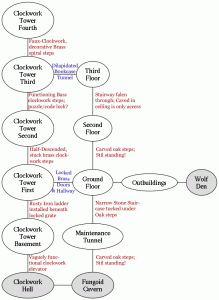The Tuesday’s Reader Tips email from Johnn Four contained a tip that expands on the work I did for the Node-Based Megadungeon.

I’m going to take the liberty of copying Lionel di Giacomo’s suggestion (and image, in case it goes away).
I love dungeon flowcharts like Keith’s, but have found transitions between “rooms” can be much smoother by adding transitional notes.
Any or all of the lines between the nodes can have brief transition descriptions to jog improvisation and help flesh out the area in my head before a game. (It also makes some good ideas for encounters between spaces. Liminal spaces are great places to challenge PCs!)
Here is an example I made out of Keith’s Abandoned Tower. [Thumbnail to the right –kjd]
I feel I need to formally respond to this.
Lionel, that’s a really good idea.
I was focused primarily on the relationships between the various nodes, and labeled them in the high-level diagram early on.
However, I did not continue that idea in later diagrams. Many of the relationships were identified in the supporting Entity Definitions, but I did not take the next step and use them as labels.
To be fair, the combined diagrams are really, really big by the time I’m done; there honestly isn’t room.
Also frankly, it didn’t even occur to me.
This is a very obvious extension of the node-based design methodology I use. Combined with Gus’ megadungeon thoughts (which I respond to here) I think there is an opportunity to take these diagrams a long way from “useful design tool” to “usable by a GM good at improv”. Between the two sets of suggestions I think much of the in-play material can be generated at need.
I don’t know that I have the chops to run a game that way. I don’t want to overprepare or bog myself down with too much material, but I have discovered that I am long enough out of the GM’s seat that my improv skills might not be quite up to this right now.
Even if I am not comfortable running a game in that manner, this is still useful as a reminder at the table and during design and preparation time. While I favor diagrams that are not overloaded with information (you should see some that I inherited at work; that I often broke each into three or four for different audiences rather than try to capture everyone’s information on one sheet of paper should be telling), this is unobtrusive and adds valuable information.
I really like this, Lionel. You’ve taken a process I use and have documented, and with a light touch added an element of significant value to it.
Thank you. This is one of the more rewarding parts of posting these things online.
Pingback: A-Z April Challenge 2013 | Keith Davies — In My Campaign - Keith's thoughts on RPG design and play.
Pingback: A-Z Challenge Forfeit | Keith Davies — In My Campaign - Keith's thoughts on RPG design and play.